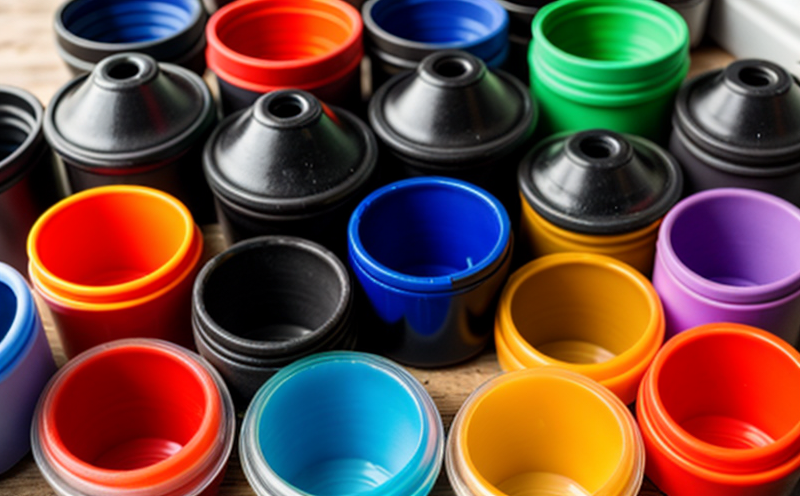EPA 8082 PCB Contaminant Testing of Recycled Plastics
The EPA Method 8082 is a critical analytical procedure designed to quantify the presence of polychlorinated biphenyls (PCBs) in recycled plastics. This method has become an indispensable tool for ensuring that reclaimed plastic materials meet stringent environmental and regulatory standards set forth by regulatory bodies such as the EPA, EU, and other national authorities.
PCBs, a group of man-made chemicals widely used in various industrial applications until their production was banned globally due to severe health risks. Despite being banned, PCBs can persist in the environment for long periods, leading to contamination in recycled plastics derived from waste streams that may include items previously manufactured with these substances.
The EPA Method 8082 involves a multi-step process that includes sample preparation, extraction of PCBs using solvent-based techniques, and subsequent analysis through gas chromatography-mass spectrometry (GC-MS). This method ensures accurate quantification of various congeners present in the plastic matrix. The importance of this test lies not only in compliance with regulatory requirements but also in safeguarding public health by minimizing exposure to these harmful chemicals.
The testing procedure is meticulously designed to handle a wide range of recycled plastic types, including those from post-consumer waste streams and industrial scrap. By providing precise data on PCB contamination levels, this test aids manufacturers and recyclers in making informed decisions regarding the use of reclaimed materials in their products.
Understanding the methodology behind EPA Method 8082 is crucial for industry professionals involved in the recycling process. Sample preparation involves thorough cleaning and drying of plastic samples to remove any surface contaminants that could interfere with the testing results. Extraction methods vary depending on the type of polymer, but common solvents like dichloromethane (DCM) are used to dissolve PCBs into a solution suitable for analysis.
The extracted solutions undergo rigorous GC-MS analysis to identify and quantify specific PCB congeners according to EPA guidelines. This process ensures that all relevant standards are met, providing accurate data on the extent of contamination in recycled plastics. Compliance with these standards is essential for maintaining product quality and ensuring environmental responsibility.
The implications of improper recycling practices can be far-reaching, affecting both human health and ecosystems. By adhering to EPA Method 8082, manufacturers can contribute positively to sustainable development goals by reducing the presence of hazardous substances in their products. This approach not only enhances corporate social responsibility but also supports broader efforts towards environmental protection.
Benefits
Implementing EPA Method 8082 for PCB contaminant testing offers numerous advantages across various sectors, particularly within the recycling industry. Compliance with this stringent testing protocol ensures that recycled plastics are safe and suitable for use in consumer goods and industrial applications.
The primary benefit is adherence to regulatory requirements set by bodies such as the EPA and other international standards organizations, thereby avoiding potential legal penalties. Additionally, it enhances brand reputation by demonstrating a commitment to environmental stewardship and public health protection.
Beyond compliance, this test also supports innovation within the recycling sector. By identifying levels of PCB contamination accurately, businesses can optimize their processes for producing cleaner recycled materials. This leads to improved product quality and performance, which ultimately translates into customer satisfaction and loyalty.
The transparent nature of EPA 8082 results fosters trust among stakeholders including suppliers, regulators, and consumers. It allows all parties involved in the supply chain to make informed decisions about the use of recycled plastics, ensuring that they meet necessary quality standards.
Industry Applications
| Application Area | Description |
|---|---|
| Consumer Goods Manufacturing | This method ensures that recycled plastics used in manufacturing consumer goods meet strict environmental and health standards. |
| Construction Industry | EPA 8082 helps verify the safety of recycled plastic products used in construction projects, ensuring they do not pose risks to occupants or the environment. |
| Sustainable Packaging Design | By testing for PCB contamination, this method supports the development of sustainable packaging solutions that are both eco-friendly and safe for end-users. |
| Automotive Sector | Achieving compliance with EPA 8082 is crucial in the automotive industry where recycled plastics play a significant role in reducing weight and improving fuel efficiency without compromising safety standards. |
| Application Area | Description |
|---|---|
| Electronics Manufacturing | This method ensures that recycled plastics used in electronics manufacturing are free from harmful contaminants, thus protecting both the environment and end-users. |
| Furniture Industry | EPA 8082 helps verify the safety of furniture made with recycled plastic components, ensuring they do not contain hazardous substances. |
| Plastic Recycling Facilities | By regularly testing incoming materials for PCB contamination, recycling facilities can maintain consistent quality and comply with stringent regulatory requirements. |
| Sporting Goods Manufacturing | This method ensures that recycled plastics used in sporting goods manufacturing meet strict environmental and health standards. |
Why Choose This Test?
EPA Method 8082 stands out for its comprehensive approach to PCB contamination testing of recycled plastics. Its precision in identifying various PCB congeners allows businesses to make well-informed decisions regarding the reuse and repurposing of plastic waste streams.
The method's wide applicability across different polymer types makes it a versatile tool for diverse industries, from consumer goods manufacturing to electronics design. Moreover, its alignment with international standards ensures that results are universally accepted and recognized by regulatory bodies worldwide.
By choosing EPA 8082 testing, organizations can enhance their reputation as leaders in sustainable practices while also protecting public health. The reliability of these tests provides confidence not only among internal teams but also external stakeholders like customers and investors who value responsible environmental stewardship.
The ease of integration into existing quality control processes further adds to its appeal. With minimal disruption required, businesses can seamlessly incorporate this testing protocol into their operations without facing significant challenges or additional costs beyond initial setup.





